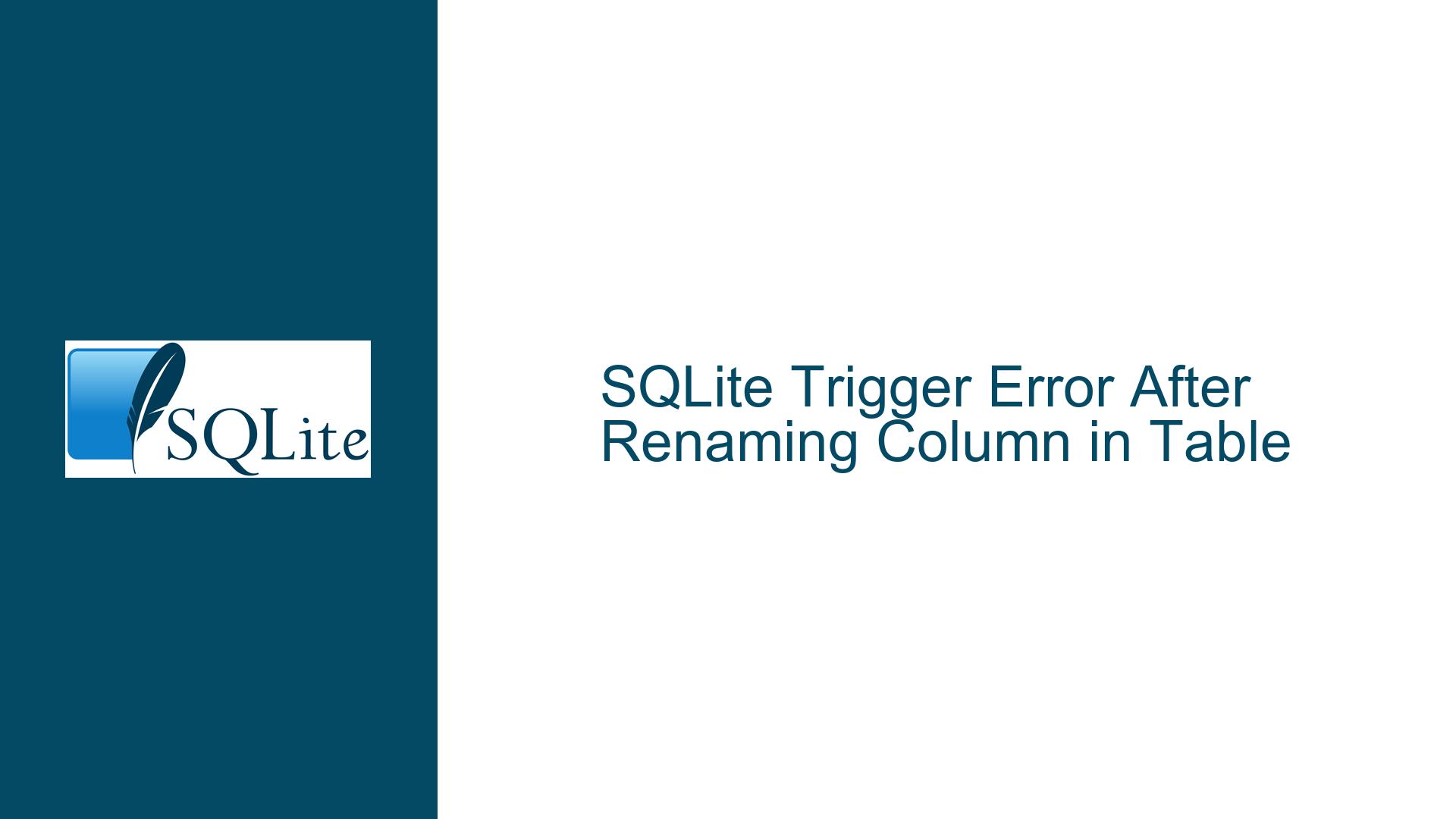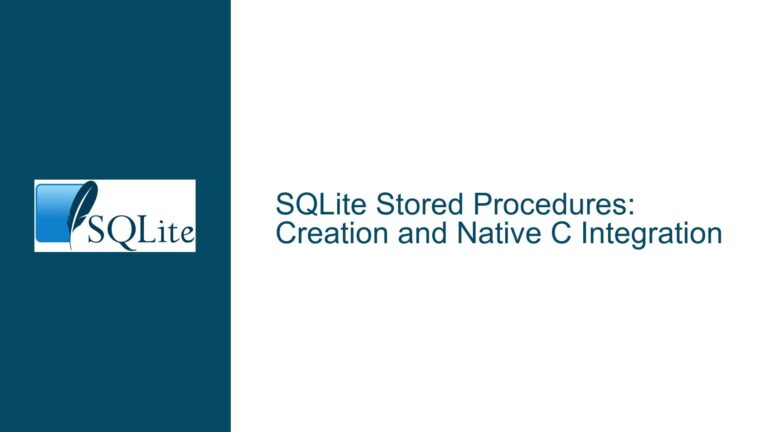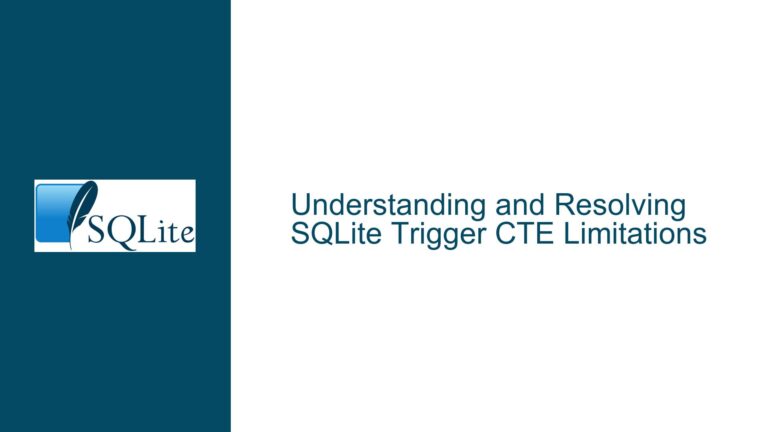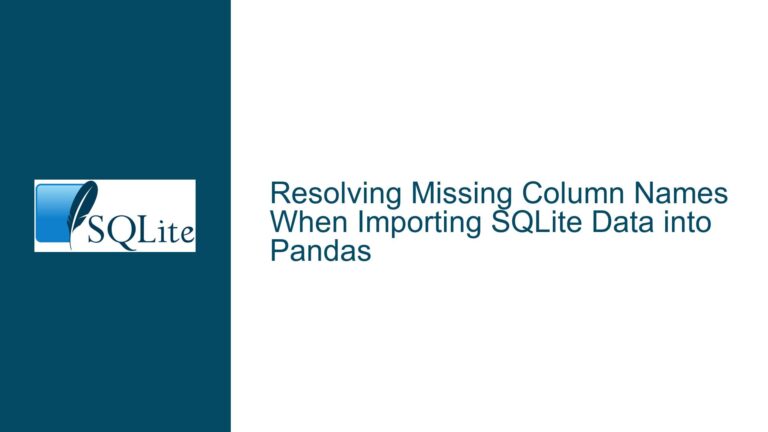SQLite Trigger Error After Renaming Column in Table
SQLite Trigger Fails After Column Rename Operation
When working with SQLite, a common but perplexing issue arises when a trigger that references a column in a table fails after renaming that column. Specifically, the error message indicates a missing column that was not renamed, which can be confusing and misleading. This issue typically manifests when a trigger is defined on a table, and subsequently, a column in that table is renamed. The error message might incorrectly point to a column that was not renamed, leading to confusion about the root cause.
In the scenario described, a trigger named t_i4bwy is created on the table t_sa. The trigger contains a complex SQL statement that references multiple columns, including c_d4u. Later, an ALTER TABLE statement is executed to rename the column c_muyat to c_dg. However, instead of the operation completing successfully, SQLite returns an error message stating that the column t_sa.c_d4u does not exist. This is puzzling because the column c_d4u was not renamed, and the trigger was created without any errors.
The core of the issue lies in how SQLite handles the internal representation of triggers and the metadata associated with them. When a trigger is created, SQLite stores the text of the trigger’s SQL statement in the sqlite_schema table. This stored text is not parsed or validated against the table schema until the trigger is actually executed or when a schema change occurs that might affect the trigger. This deferred validation can lead to situations where a trigger that appears to be valid at creation time fails later when a schema change is made.
Deferred Trigger Validation and Column Renaming
The root cause of the error message lies in the deferred validation of triggers in SQLite. When a trigger is created, SQLite does not immediately validate all the columns referenced in the trigger’s SQL statement against the current table schema. Instead, this validation is deferred until the trigger is executed or when a schema change occurs that might affect the trigger. This deferred validation can lead to situations where a trigger that appears to be valid at creation time fails later when a schema change is made.
In the case of renaming a column, SQLite updates the schema to reflect the new column name. However, the text of the trigger’s SQL statement stored in the sqlite_schema table is not automatically updated to reflect the new column name. When the trigger is subsequently executed or when SQLite attempts to validate the trigger after a schema change, it uses the original text of the trigger’s SQL statement. If this text references a column that has been renamed, SQLite will not be able to find the column, resulting in an error.
The error message in this case is particularly confusing because it points to a column (c_d4u) that was not renamed. This is likely due to the way SQLite parses and validates the trigger’s SQL statement. When SQLite encounters a reference to a column that no longer exists (due to renaming), it may incorrectly report the error as being related to a different column in the same table. This can make it difficult to diagnose the issue, especially in complex triggers with multiple column references.
Resolving Trigger Errors After Column Renaming
To resolve the issue of trigger errors after renaming a column, it is necessary to manually update the trigger’s SQL statement to reflect the new column name. This can be done by dropping the existing trigger and recreating it with the updated SQL statement. Here are the detailed steps to achieve this:
First, retrieve the original SQL statement used to create the trigger. This can be done by querying the sqlite_schema table:
SELECT sql FROM sqlite_schema WHERE type = 'trigger' AND name = 't_i4bwy';
This query will return the original SQL statement used to create the trigger t_i4bwy. Next, modify this SQL statement to replace the old column name (c_muyat) with the new column name (c_dg). Once the SQL statement has been updated, drop the existing trigger:
DROP TRIGGER t_i4bwy;
Finally, recreate the trigger using the updated SQL statement. For example:
CREATE TRIGGER t_i4bwy AFTER DELETE ON t_sa
FOR EACH ROW
BEGIN
DELETE FROM t_sa
WHERE
(CASE WHEN t_sa.c_d4u <> (
SELECT
t_sa.c_lngdt AS c0
FROM
t_k AS ref_8
WHERE t_sa.c_c3v IS NOT t_sa.c_dg
WINDOW oamat7fzf AS (PARTITION BY t_sa.c_d4u ORDER BY t_sa.c_d4u, t_sa.c_d4u ASC)
) THEN t_sa.c_d4u ELSE t_sa.c_d4u END
NOT LIKE 'so8%pjs');
END;
By following these steps, the trigger will be updated to reference the new column name, and the error should be resolved. It is important to note that this process must be repeated for any other triggers that reference the renamed column.
In addition to manually updating triggers, it is also a good practice to review and test all triggers after making schema changes to ensure that they continue to function correctly. This can help to identify and resolve any issues before they cause problems in a production environment.
To further illustrate the process, consider the following table that summarizes the steps involved in resolving trigger errors after renaming a column:
| Step | Action | SQL Command |
|---|---|---|
| 1 | Retrieve the original SQL statement for the trigger | SELECT sql FROM sqlite_schema WHERE type = 'trigger' AND name = 't_i4bwy'; |
| 2 | Modify the SQL statement to replace the old column name with the new column name | Manual update of the SQL statement |
| 3 | Drop the existing trigger | DROP TRIGGER t_i4bwy; |
| 4 | Recreate the trigger with the updated SQL statement | CREATE TRIGGER t_i4bwy ... |
By following these steps, you can ensure that your triggers continue to function correctly after renaming columns in your SQLite database. This approach not only resolves the immediate issue but also helps to prevent similar problems in the future by ensuring that all database objects are kept in sync with the current schema.
In conclusion, the issue of trigger errors after renaming a column in SQLite is a result of deferred trigger validation and the way SQLite handles schema changes. By understanding the underlying cause and following the steps outlined above, you can effectively resolve these errors and maintain the integrity of your database schema.






